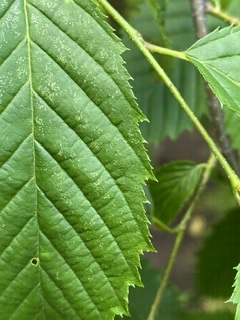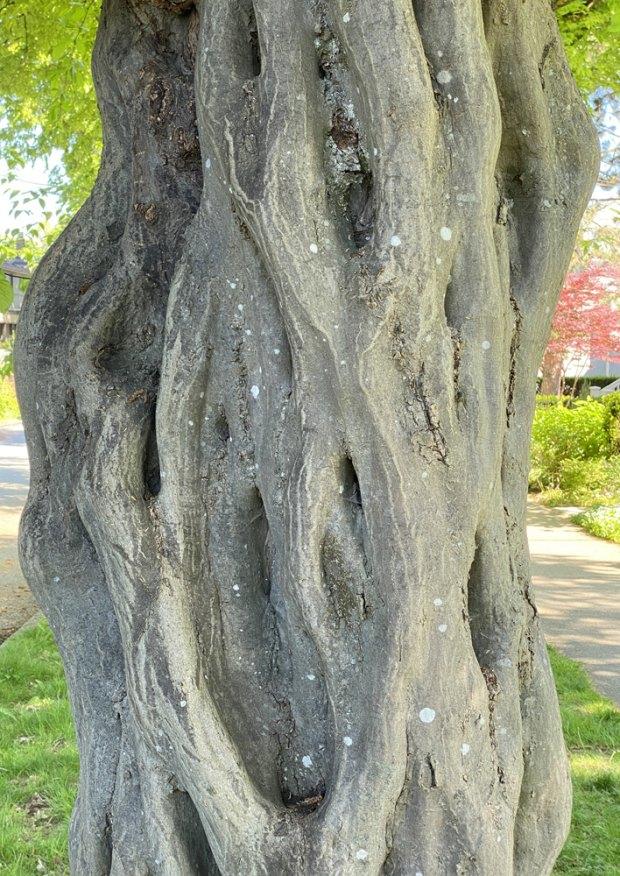
The tree’s trunk is braided, fluted, and made of sculptured vertical hills and valleys, some thick.
The moment I see the photograph of the unusual trunk of this mystery tree and I notice the email’s subject—“Tree Identifying Help?”—I am hooked. This is a mystery I want to solve.
The local gardener who wonders which tree species has such a sculptured trunk thinks it might be an alder or a birch tree, because its leaves are oval and serrated. I can’t see leaf detail in the emailed photo. Clearly a puzzle.
I check the City of Vancouver’s Open Data Portal on Street Trees. It states the tree is Fagus sylvatica, a European beech.[i] One of the most identifiable features of a beech tree, whether it’s an American or a European beech, is its elephant-leg trunk. This tree does not have an elephant-leg trunk. I suspect it is not a beech tree.
According to Vancouver’s street tree portal, the entire east side of the 4100 block of East Prince Edward Street, south of East King Edward Avenue, is planted with European beech trees. Except there is one lone Carpinus japonicus, a Japanese hornbeam, an anomaly among the beeches. The hornbeam isn’t quite where the mystery tree is, but nevertheless, I look up images of a Japanese hornbeam online. Not a match. Japanese hornbeam is a very small tree, the smallest of the hornbeams. The trunk looks nothing like the mystery tree’s trunk.
Even though I am certain the mystery tree is not a Japanese hornbeam, the mention of hornbeams—deciduous hardwood trees—starts me wondering whether this is a breadcrumb worth following.
When I began learning to identify tree species some years ago, in readiness for writing Legacy of Trees: Purposeful Wandering in Vancouver’s Stanley Park, the identification of Carpinus betulus, European hornbeam, evaded me. Now, however, I can almost always recognize them.
The most frequently planted European hornbeam is an erect cultivar known as ‘Fastigiata’. This cultivar name describes the tree’s penchant for growing branches that are upright, hugging the central trunk. As Gerald B. Straley points out in Trees of Vancouver, this cultivar borders traffic-heavy 1st Avenue East from Clark Drive to Victoria Drive. The hornbeams create an avenue of deep green that embraces commuters as they enter and leave the city. Tall trucks and trailers traversing this route keep the sides of the trees pruned. Fortunately, European hornbeam is a forgiving species, putting up with such rough treatment, and contentedly growing in poor conditions, pest- and disease-free. The fastigiate cultivar makes a perfect boulevard tree, starting out slim and tall, and becoming vase shaped as it grows. In its prime after four or more decades, it can reach 12 metres tall with a 10-metre spread.
There is another gorgeous display of European hornbeams along Beach Avenue from Thurlow Street to Jervis Street.[ii]

The immense mass of green foliage lifts smoothly up to the sky from slim trunks and multiple leaders , vaselike.
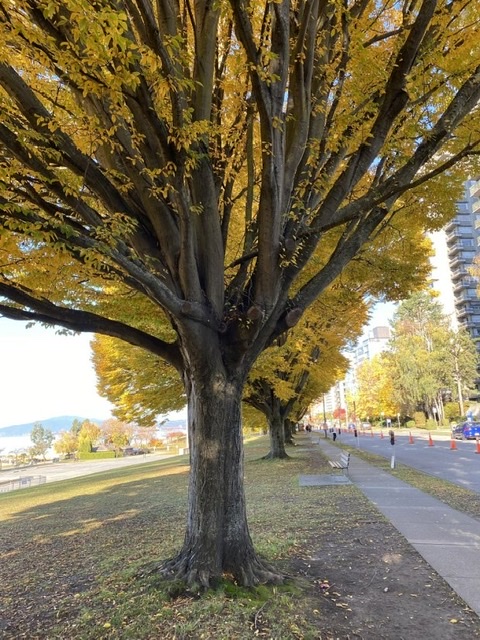
Now, working on the hornbeam clue, I check Douglas Justice’s Vancouver Trees app, which has photos of only one hornbeam species: Carpinus betulus, European hornbeam, the one with leaves like birch tree leaves, as denoted in the species epithet betulus.[iii] Top marks to the local gardener who recognized the leaves as being similar to birch leaves.
The app also names three other hornbeam species: C. japonicus, the smallest (I have already determined it is not a contender); C. caroliniana, whose species epithet suggest it was discovered in the Carolinas; and C. cordata, one with heart-shaped leaves. C. cordata does not look like a boulevard tree, because its round, stocky trunk would take up too much width of the sidewalk.
That leaves C. caroliniana.
When I enter “Carpinus caroliniana org” into a Google image search, up pop photos of trees that could be siblings of the mystery tree. A native of Missouri (a couple of states away from North and South Carolina), one of the tree’s common names is American hornbeam. Another is blue beech, which undoubtedly would add to genus and species confusion in a tree nursery, leading to further confusion when data is entered in the City of Vancouver’s data portal. True beech trees are in the Fagaceae Family, whereas hornbeams are in the Betulaceae Family, the same family as birch trees.
The mystery is solved definitively when I discover the validating factor: C. caroliniana’s other common name is musclewood. That name perfectly describes the trunk’s thick and thin vertical hills and valleys—muscles! Its muscles are carved, just like you see on the legs of a cyclist or a long distance runner.
Now it is time to drive over to the heart of Vancouver’s Riley Park neighbourhood to see the mystery tree for myself.

The well-muscled musclewood can be viewed in the 4100 block of East Prince Edward Street. After all the time spent looking at its photo, it is great to feel the smoothness of the interlocking muscles of the light grey trunk. I am able to get a good look at the leaves—alternate, oval, one deeply grooved central vein, deep side veins, doubly toothed leaf margins. I take my own photos of the tree.
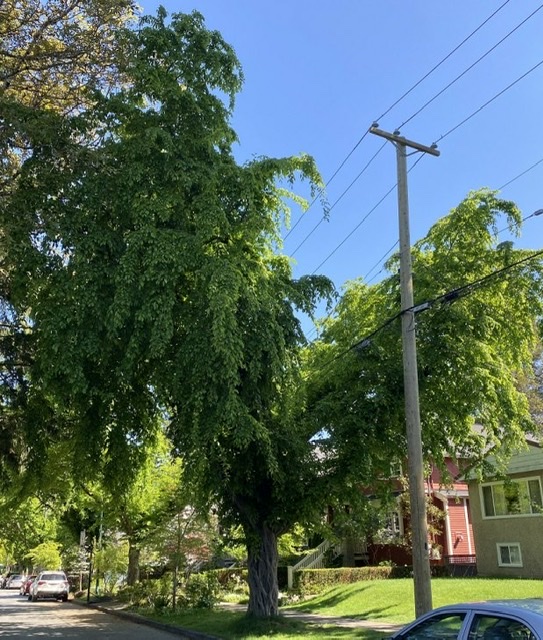
Even though Carpinus is a genus of forgiving trees, this one may not live forever, split in two as it is by residential power lines.
However, we know from its cousins on 1st Avenue East that the Carpinus genus doesn’t mind poor conditions.
With the mystery solved, I decide to check out other musclewoods in the city. According to Vancouver’s street tree portal, 490 C. caroliniana trees are planted in Vancouver, including three dozen young fastigiate trees between the road and the new two-way cycle path on downtown Richards Street in the three blocks between Nelson Street and Georgia Street. In time, they will develop their muscles and look really interesting.
Other downtown specimens of C. caroliniana are older trees with rather ordinary trunks.
But there are two young C. caroliniana in the West End—at 1111 and 1230 Haro Street.
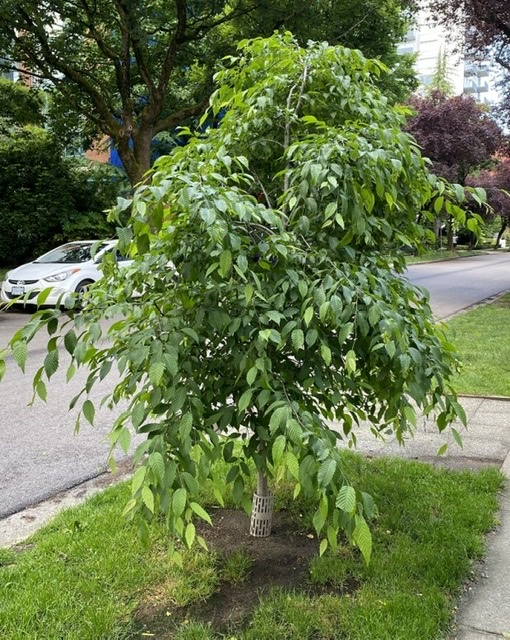
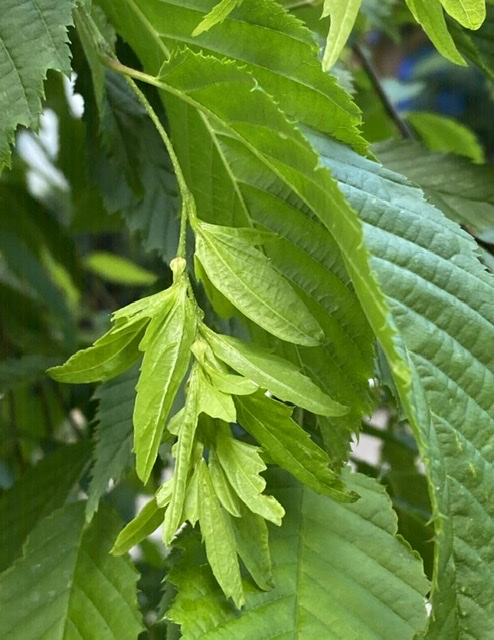
I will be watching them in the years to come. They were planted in 2019 and are far from fastigiate. Instead, they are already spreading their branches widely. The chains of barely noticeable flowers emerge in early spring and are wind pollinated. In mid-June one of these young trees is sporting chains of papery fruit, protected by bracts around and leaves above.
Often, we know a tree by its wood: knotty pine panelling, an oak corner cabinet, a mahogany dining table, a walnut chair. Very little wood can be garnered from a musclewood tree: the deep grooving of muscles limits the cross sections of wood. However, I note that its wood is used for tool handles, walking sticks, and golf clubs, all instruments requiring shock resistance, strength, and muscles.
Photos and Article: Nina Shoroplova, Vancouver Master Gardener
[i] https://opendata.vancouver.ca/explore/dataset/street-trees
[ii] Straley, Trees of Vancouver: A Guide to the Common and Unusual Trees of the City, UBC Press, 1992, p. 84.
[iii] Vancouver Tree app
